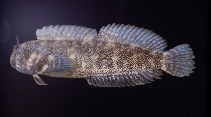| Family: |
Blenniidae (Combtooth blennies), subfamily: Salariinae |
| Max. size: |
18 cm TL (male/unsexed) |
| Environment: |
demersal; marine; depth range 0 - 2 m |
| Distribution: |
Western Indian Ocean: Seychelles (Ref. 26282) and Maldives. Eastern Indian Ocean: Christmas Island (Ref. 30874). |
| Diagnosis: |
Dorsal spines (total): 13-13; Dorsal soft rays (total): 15-17; Anal spines: 2-2; Anal soft rays: 16-18. Overall greenish, large white blotches superimposed on intricate maze-like pattern, and yellowish margins on median fins. Dorsal rays rarely 15, fin deeply notched; anal rays rarely 16; pectoral rays usually 14; pelvic spine not visible externally; last lateral-line tube below 8th to 13th dorsal spines; nape typically with 1 cirrus on each side; supraorbital tentacle with 2-38 cirri (number proportional with growth); anterior nostril cirri present posteriorly; upper lip margin entirely, but weakly and irregularly crenulate; body depth at anal-fin origin about 4.1-4.5 in SL (Ref. 90102). |
| Biology: |
Adults are found in the intertidal area, actively shuttling back and forth between rock pools and air (Ref. 31184). They breathes air when out of water (Ref. 31184). Oviparous. Eggs are demersal and adhesive (Ref. 205), and are attached to the substrate via a filamentous, adhesive pad or pedestal (Ref. 94114). Larvae are planktonic, often found in shallow, coastal waters (Ref. 94114). |
| IUCN Red List Status: |
Least Concern (LC); Date assessed: 27 March 2009 Ref. (130435)
|
| Threat to humans: |
harmless |
Source and more info: www.fishbase.org. For personal, classroom, and other internal use only. Not for publication.

